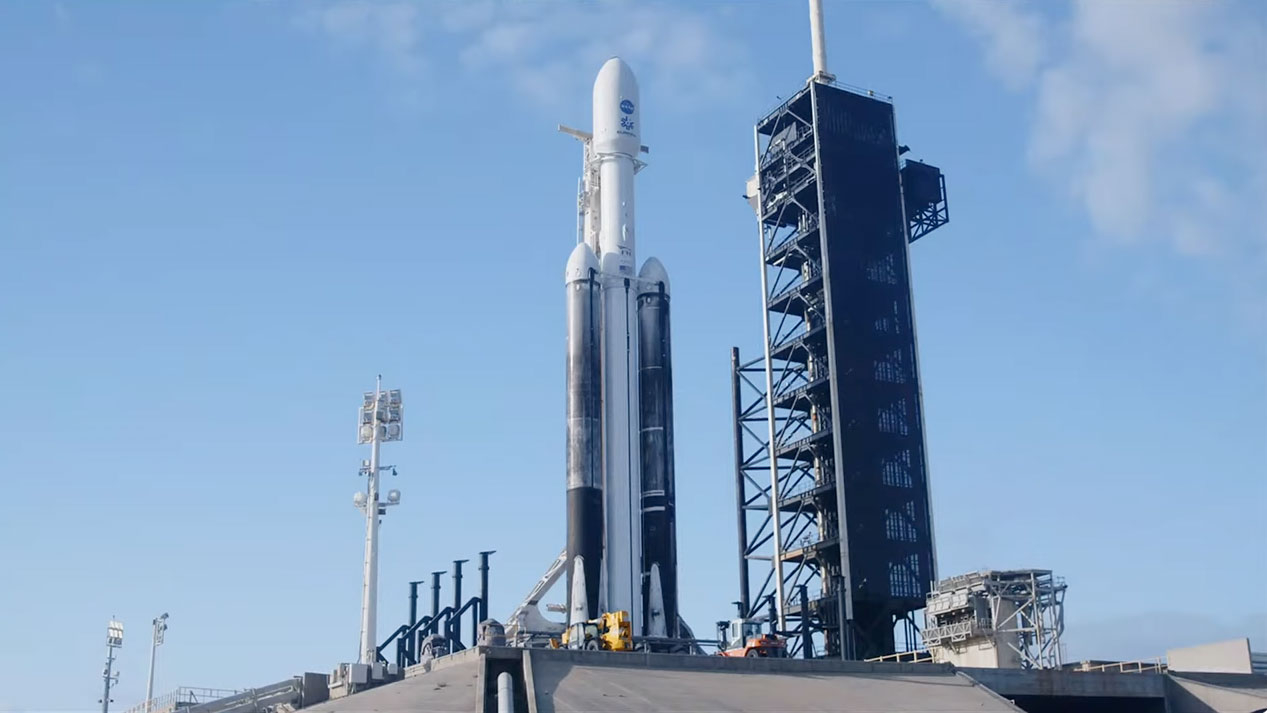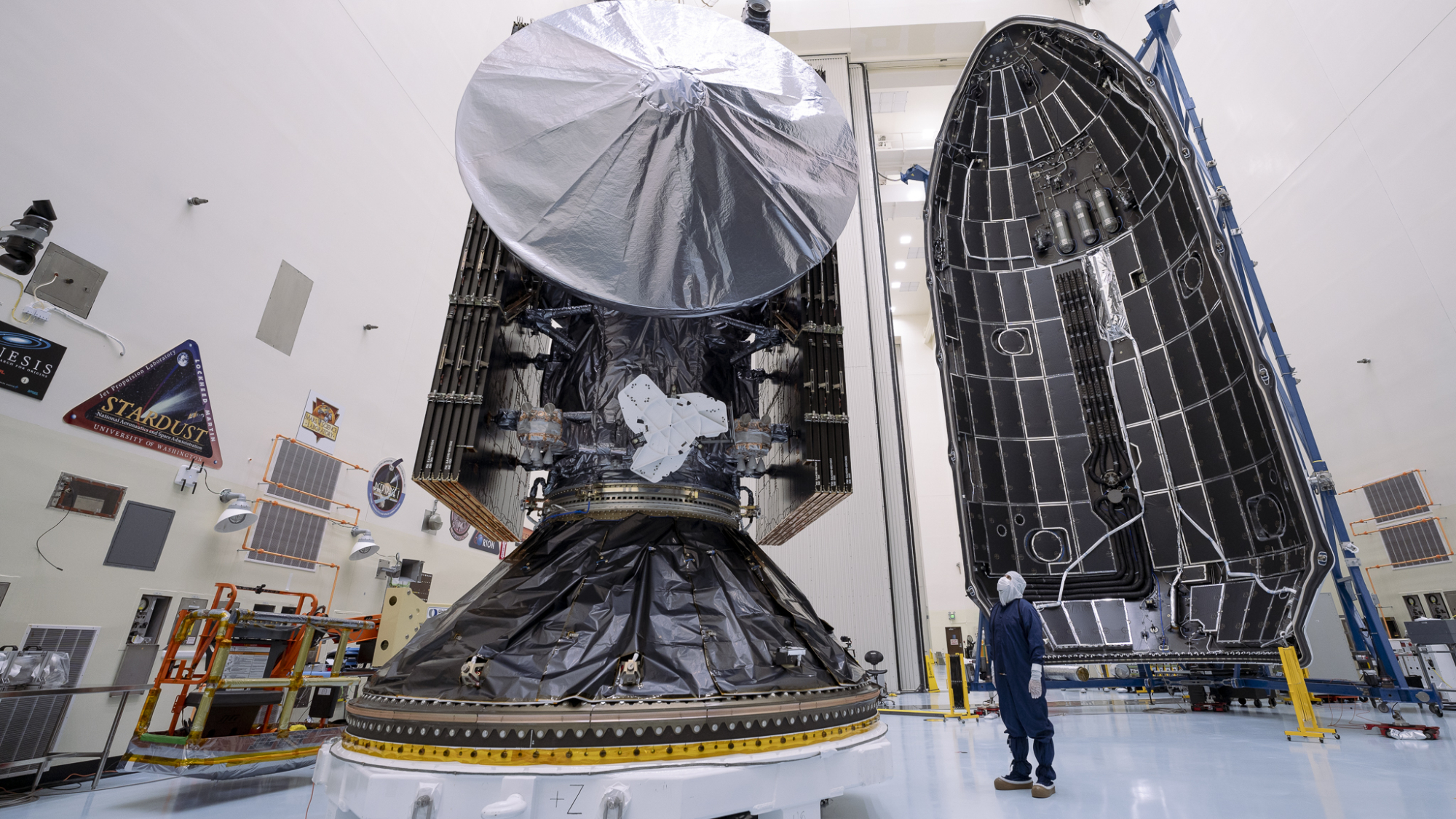What time will SpaceX launch NASA's Europa Clipper to icy Jupiter moon today (and how to watch online)?
NASA's Europa Clipper is scheduled to launch at 12:06 p.m. EDT (1606 GMT) today (Oct. 14), but it could fly anytime through Nov. 6.
Update for 1:30 p.m. EDT: SpaceX and NASA have successfully launched the Europa Clipper spacecraft toward Jupiter. Read our full wrap story for launch video, photos and more.
NASA's first mission to another ocean world in our solar system will launch toward Jupiter today (Oct. 14), but if you want to watch it live, you'll need to know when to tune in.
Europa Clipper, a $5 billion NASA mission to study the salty ocean beneath the ice of Jupiter's moon Europa, will launch on its way Monday atop a SpaceX Falcon Heavy rocket. Liftoff is set for 12:06 p.m. EDT (1606 GMT) from Pad 39A at NASA's Kennedy Space Center near Cape Canaveral, Florida.
"Clipper is the first NASA spacecraft dedicated to studying an ocean world beyond Earth," NASA Associate Administrator Jim Free told reporters in a briefing on Sunday evening (Oct. 13). Europa has long been on scientists' short list of most promising places that could support life beyond Earth. The Europa Clipper probe, Free said, aims to understand just how habitable the icy moon really is. Here's when and how to watch the Europa Clipper mission launch online.
What time is the Europa Clipper launch?

NASA is currently targeting Monday, Oct. 14, at 12:06 p.m. EDT (1606 GMT) to launch the Europa Clipper mission on a SpaceX Falcon Heavy rocket. The mission will have a 15-second launch window in which to lift off, with SpaceX aiming for the end of that opportunity. There is a 95% chance of good weather at launch time.
SpaceX initially aimed to launch Europa Clipper on Oct. 10, but postponed the flight due to the approach of Hurricane Milton, which swept across Florida in the days leading up to that launch attempt, leaving millions without power across the state. The storm damaged some parts of Kennedy Space Center, but the center opened a few days later to resume Europa Clipper launch preparations.
"The SpaceX and NASA teams did a great job keeping hardware safe," Free said in the briefing, adding that his heart goes out to all those affected by Hurricane Milton and Hurricane Helene, which preceded it.
Can I watch the Europa Clipper launch online?
Yes, you'll be able to watch the Europa Clipper launch online. In fact, you have several options on where to tune in.
NASA will offer a free webcast in English for the launch on its NASA+ streaming service, as well as its NASA YouTube page, starting at 11 a.m. EDT (1500 GMT). Spacec.com will simulcast this livestream on our VideoFromSpace YouTube channel, as well as on our homepage and at the top of this page.
NASA will also offer an alternative Spanish-language feed on NASA+ to chronicle the mission.
SpaceX, meanwhile, may offer its own livestream of the Europa Clipper launch atop its Falcon Heavy rocket via its X page, though the company is currently referring viewers to NASA's livestream.
How long is the Europa Clipper mission?
From start to finish, NASA's Europa Clipper is currently expected to last nearly 10 years, with the first 5.5 years spent on the voyage to Jupiter and Europa, a trip of 1.8 billion miles (2.9 billion kilometers). The launch, however, should only take just over an hour from liftoff to spacecraft deployment, followed by a six-hour process to unfold its solar arrays.
If all goes well, Europa Clipper will swing by Mars in March 2025 and then Earth in December 2026 to get gravity boosts from each planet. Those encounters will place the probe on track to arrive at Jupiter on April 11, 2030. The mission is overseen by NASA's Jet Propulsion Laboratory in Southern California.
Once at Jupiter, the spacecraft will spend the next four years making a series of close flybys of Europa to study the moon's icy ocean with a suite of nine different instruments and an experiment, all of which are aimed at understanding the salt-water ocean beneath the moon's surface. A radar will probe the depths of that ocean, while other instruments will measure water plumes detected on Europa by the Hubble Space Telescope. And, of course, there's the camera images Clipper will take of Europa, NASA officials said.

"While we're not going to search for other life, Europa could have the ingredients for life as we know it: water, organics, chemical energy and stability," Free said. "What we discover at Europa will have profound implications for the study of astrobiology and and how we have how we view our place in this universe."
While its primary mission is due to end by June 2034, it is possible NASA may extend the Europa Clipper mission beyond that year depending on the health of the spacecraft.
Below is a look at the launch countdown and timeline for deployment of Europa Clipper from its Falcon Heavy rocket. Unlike past Falcon Heavy launches, SpaceX will not attempt to recover the first stage or side boosters on this flight in order to get as much performance from the boosters as possible. Europa Clipper is the size of a tennis court with its solar arrays unfurled, making it NASA's largest planetary probe yet, SpaceX said.
"Falcon Heavy is giving Europa Clipper its all, sending the spacecraft to the farthest destination it's ever sent, which means the mission requires the maximum performance, so we won't be recovering the boosters tomorrow," Julianna Scheiman, SpaceX's director of NASA science missions at SpaceX, told reporters Sunday. "I don't know about you guys, but I can't think of a better mission to sacrifice boosters for, for we might have an opportunity to discover life in our own solar system. How cool is that?"
| Time (hr/min/sec) | Event | Header Cell - Column 2 |
|---|---|---|
| T-00:53:00 | Launch director 'go' for fueling | Row 0 - Cell 2 |
| T-00:50:00 | 1st stage RP-1 fueling begins | Row 1 - Cell 2 |
| T-00:45:00 | 1st stage liquid oxygen loading begins | Row 2 - Cell 2 |
| T-00:35:00 | 2nd stage RP-1 fueling begins | Row 3 - Cell 2 |
| T-00:18:30 | 2nd stage LOX loading | Row 4 - Cell 2 |
| T-00:07:00 | Falcon Heavy engine chilldown | Row 5 - Cell 2 |
| T-00:00:59 | Flight computer's final prelaunch checks | Row 6 - Cell 2 |
| T-00:00:45 | Launch director 'go' for launch | Row 7 - Cell 2 |
| T-00:00:20 | Propellant tanks pressurize for launch | Row 8 - Cell 2 |
| T-00:00:06 | Engine ignition sequence start | Row 9 - Cell 2 |
| T-00:00:00 | Liftoff! | Row 10 - Cell 2 |
| Time (hrs/min/sec) | Event | Header Cell - Column 2 |
|---|---|---|
| T+00:01:07 | Max Q | Row 0 - Cell 2 |
| T+00:03:03 | Side boosters engine cutoff | Row 1 - Cell 2 |
| T+00:03:07 | Side boosters separate | Row 2 - Cell 2 |
| T+00:04:02 | 1st stage main engine cutoff | Row 3 - Cell 2 |
| T+00:04:06 | Stage separation | Row 4 - Cell 2 |
| T+00:04:13 | 2nd stage engine start | Row 5 - Cell 2 |
| T+00:04:31 | Payload fairing jettison | Row 6 - Cell 2 |
| T+00:07:53 | 2nd stage engine cutoff 1 | Row 7 - Cell 2 |
| T+00:47:40 | 2nd stage engine restart | Row 8 - Cell 2 |
| T+00:50:56 | 2nd stage engine cutoff (final) | Row 9 - Cell 2 |
| T+01:02:12 | Europa Clipper deploys | Row 10 - Cell 2 |
What if Europa Clipper can't launch on Oct. 14?
If SpaceX is unable to launch NASA's Europa Clipper spacecraft on Oct. 14, the company does have at least two more chances this week.
SpaceX's first backup launch date is on Tuesday, Oct. 15, at 11:59 a.m. EDT (1559 GMT), with weather forecasts calling for a 95% chance of good conditions at launch time, according to the U.S. Space Force's 45th Weather Squadron. If SpaceX and NASA have to wait another day, they could try to launch Europa Clipper on Wednesday, Oct. 16, at 11:52 a.m. EDT (1552 GMT) as the launch window moves earlier each day. There is an 80% chance of good launch conditions on Wednesday.
In fact, NASA and SpaceX could launch Europa Clipper any day through Nov. 6 and still get the spacecraft to the Jupiter system by April 11, 2030.
"So each of the dates on the launch period end up changing the date at which we do a gravity assist at Mars and a gravity assist at Earth," said Jordan Evans, Europa Clipper project manager at NASA's Jet Propulsion Laboratory. "But other than that, all trajectories arrive at Jupiter on April 11, 2030."
Editor's note: Visit Space.com on Oct. 14 for complete coverage of the Europa Clipper mission.
Join our Space Forums to keep talking space on the latest missions, night sky and more! And if you have a news tip, correction or comment, let us know at: community@space.com.
Get the Space.com Newsletter
Breaking space news, the latest updates on rocket launches, skywatching events and more!

Tariq is the Editor-in-Chief of Space.com and joined the team in 2001, first as an intern and staff writer, and later as an editor. He covers human spaceflight, exploration and space science, as well as skywatching and entertainment. He became Space.com's Managing Editor in 2009 and Editor-in-Chief in 2019. Before joining Space.com, Tariq was a staff reporter for The Los Angeles Times covering education and city beats in La Habra, Fullerton and Huntington Beach. In October 2022, Tariq received the Harry Kolcum Award for excellence in space reporting from the National Space Club Florida Committee. He is also an Eagle Scout (yes, he has the Space Exploration merit badge) and went to Space Camp four times as a kid and a fifth time as an adult. He has journalism degrees from the University of Southern California and New York University. You can find Tariq at Space.com and as the co-host to the This Week In Space podcast with space historian Rod Pyle on the TWiT network. To see his latest project, you can follow Tariq on Twitter @tariqjmalik.










